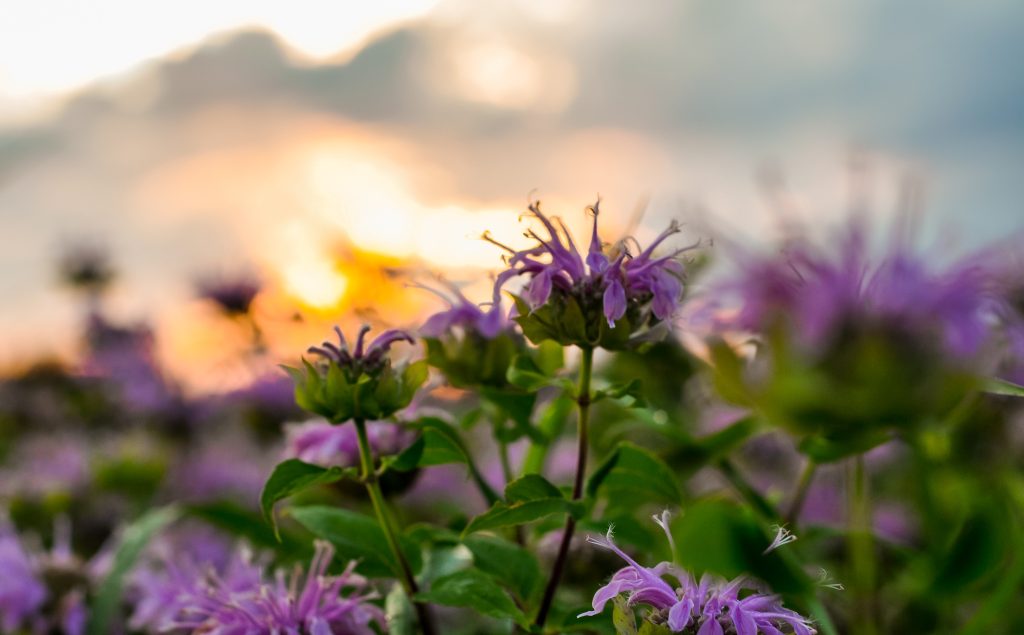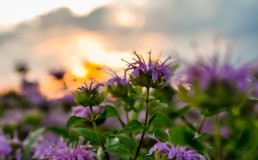Learning Herbal Medicine: Wild Bergamot
Already longing for some summer-time herbs? Please enjoy this guest blog by Taylor Eveson discussing some of the medicinal uses and properties of Wild Bergamot!
Wild Bergamot
Scent: Aromatic and Pungent
Botanical name: Monarda fistulosa
Common names: Wild Bergamot, Sweet Leaf, Indian Perfume, Horsemint.

Identification
Wild bergamot is a perennial herb from the mint family. Like many other mints it has a square stem and opposite leaves. The leaves (5-8cm) are lanceolate with toothed margins and the bracts (the leaves just underneath the flowers) can be coloured with red or purple. Many stalks can sprout from the same root (known as a rhizome), so it is common to find several plants clustered together. It can grow to a height of almost a meter. From June to September it sprouts 20-50 flowers from the receptacle at the terminal end of the stalk. The tubular, irregular flowers can be varying shades of purple, lilac, pink or rarely white. The fruit is a nutlet, tightly clustered with many other nutlets. When the fruits ripen, they change colour from green to brown or black.
Habitat
It grows in rich, limey soils in dry fields, thickets and clearings. It prefers open fields and meadows that have not been cultivated for some time. It is distributed from Quebec to the Northwest Territories and British Columbia, and as far South as Georgia, Texas, Idaho and Northeast Washington. Some varieties are geographically widespread, but others are quite restricted to their range. Personally, I have been able to grow more than one variety of wild bergamot in a garden bed on a roof in Toronto; it did quite well as long as I watered it regularly.
Traditional Uses
Wild bergamot has many uses in traditional Native American culture. Due to its widespread distribution, many tribes utilized this plant including the Blackfoot, Cherokee, Chippewa, Cree, Iroquois, Ojibwa and Sioux nations. A Cherokee native, Tis Mal Crow, describes it as the medicine that draws out the fire, being particularly suited for burns and heat from fevers or infection. The Blackfoot applied a poultice of the flowers to burns or a burst boil, and after the wound was healed. Chippewa natives applied a poultice of crushed leaves to the head for headaches, and other tribes stuffed crushed leaves into the nostrils for the same purpose. Cherokee natives inhaled the steam from a hot infusion and also drank the tea for ‘sweating off’ flus and fevers.
In native American culture the concept of animal medicine archetypes is an interesting area of study. The indigenous people studied animals to learn about themselves and the medicines in their area. There were qualities about certain plants that merited an association to a particular animal; whether it was a favourite food of a particular animal, or some part of the plant bore physical resemblance to that animal, they recognized that the way animals related to plants contributed to why the animal was the way it was. So if they desired to attain to the nature of the bear or the deer, they would use the foods or medicines associated with that animal to achieve this end.
Wild bergamot is described as having a deer medicine animal signature. American herbalist Matthew Wood describes the plant as having long, slender stalks like a deer’s legs, supporting flowering heads that resemble a head with horns, or a rack of antlers. You can find the plant growing where deer like to graze near the edge of a forest, where they can quickly find cover if they sense danger. Male elks will roll in a patch of bergamot to attract a mate. The name “Indian Perfume” comes from its pleasant fragrance and its use as an aphrodisiac or in love potions. The deer archetype is associated with virility, love, passion and ‘the hunt’. The indigenous peoples believe the same vital energy is involved in hunting for a mate, or for prey; deer medicines fortify the body’s ability to perform in this regard. These medicines have a particular affinity for supporting the kidneys and the nervous system, both of which are intimately connected to the acuity of the sensory perceptions and are involved in the ‘fight or flight’ adrenal response to external stress.
Uses and Application
During a viral infection, the body initiates a variety of immune responses. Most notably, the core temperature is increased to a point that is uninhabitable for the virus. An individual will have the urge to curl up in bed to build their temperature. This internal increase in temperature is followed by a release of the heat through the exterior of the body by conductive heat transfer and sweating. The process of relaxation of the periphery of the body and attendant sweating is called diaphoresis. Warming, aromatic medicinal herbs like wild bergamot are known as diaphoretics. They stimulate the increase of the core temperature and allow blood vessels and surrounding tissues to relax so that the heat and the byproducts of cellular breakdown produced in the fight against the infection can be eliminated more easily through the skin and the digestive and urinary tracts.
The oil produced by wild bergamot is high in a volatile oil called thymol. Thymol is a powerful antiseptic for both internal and external use. It is also employed as a deodorant and local anesthetic. It is extensively used to medicate gauze and wool for surgical dressings. It is also utilized for commercial mouthwash production. Many different activities of thymol such as antioxidant, anti-inflammatory, and especially antibacterial and anti-fungal properties have been shown.
Indications: Fevers, headaches, lack of perspiration, respiratory infections, coughs, sore throat, colds and flus, cool and damp skin with internal heat, skin rashes, dermatitis, bug bites and stings, burns, depression, anxiety, insomnia, nervous hyperactivity, colic, flatulence, indigestion, poor appetite, diarrhea, constipation, menstrual cramps, candidiasis, urinary tract infections.
Herbal Actions: aromatic, diaphoretic, diuretic, antibacterial, anti-fungal, expectorant, carminative, nervous system restorative.
Energetics: Pungent, warming, aromatic, salty, savoury, draws out heat.
Dosage Examples
Infusion: 1 gram of dried herb per 5mL of water; 3-4 cups of tea a day or as a gargle, wash or steam inhalation.
Tincture: Fresh 1:2, dried 1:5; 5 mL or one teaspoon, 3-5 times daily.
Topical: Chewed or crushed leaves (from flowering plant) should not be left on the affected area for more than 5 minutes; its effect can become too hot and irritating. Steep a large handful into boiling water for 30-35 minutes and add infusion to bath water for sore muscles and nervous system conditions.
Photo provided by Serena Mor

